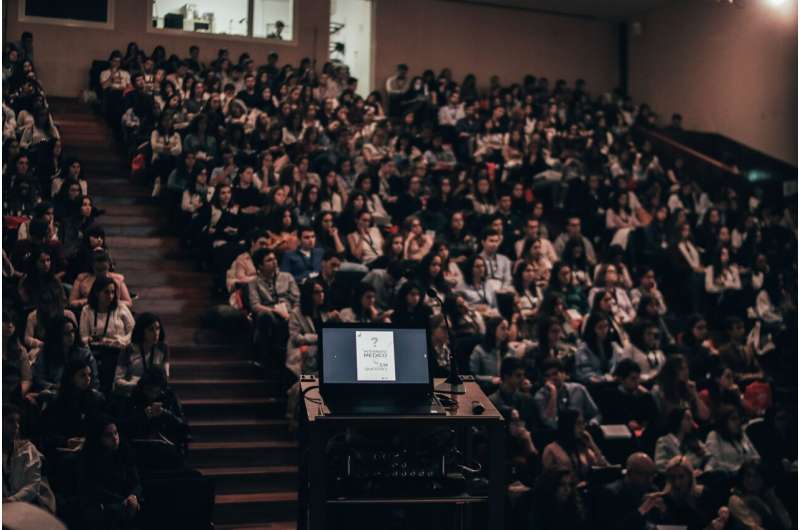This article has been reviewed according to Science X's editorial process and policies. Editors have highlighted the following attributes while ensuring the content's credibility:
fact-checked
peer-reviewed publication
trusted source
proofread
Students who see science in the real world are more likely to stick with STEM majors, finds study

Giving new college students opportunities to reflect on the ways science, technology, engineering and math can affect their lives makes them more likely to remain in degree programs in STEM fields, according to new research from the University of Wisconsin–Madison.
The effects described in the study, published May 1 in Proceedings of the National Academy of Sciences, were particularly strong for students from racial and ethnic groups underrepresented in STEM—science, technology, engineering and math—disciplines.
More than 2,500 students enrolled in an introductory chemistry course—nearly all in their first year of college—participated in the study. Three times throughout the course, the students were given writing assignments about concepts covered in class, such as "What factors determine the pressure of a gas?"
Half the students, the control group, were directed to write essays that addressed the question. The other half were told they also needed to explain how the scientific concept could be applied either to their own life or to helping others.
"Their answers weren't always deep reflections," says Judith Harackiewicz, a UW–Madison psychology professor who studies motivation, and whose lab has been studying students in science classes for more than a decade. "Some students did write about important connections—such as how a chemistry concept might help a relative with cancer—but others were as simple as how this relates to baking a pan of brownies for their friends."
The impact of the reflection, however, was significant. Students who were asked to consider how science was relevant to them or society were 4 percentage points more likely to be majoring in a STEM field 2.5 years after the chemistry course (74% vs. 70% for the control group). Students who identify as members of underrepresented groups less likely to study and work in STEM disciplines—including Alaska Native, American Indian, Black, Hispanic or Latino/Latina, and Pacific Islander—and were assign the additional personal writing were 14 percentage points more likely to be on the path to a STEM degree 2.5 years later (69% versus 55% for the control group).
The differences are particularly striking, according to the researchers, because they show that a small change in the science curriculum can help students stay on the path that brought them to introductory chemistry in the first place.
"At the beginning of this chemistry course, 94% of students told us they planned to major in a STEM field," says Michael Asher, a UW–Madison graduate student and first author of the study. "It's a critical time for them. A lot of prior research shows that students can start to feel disconnected from their long-term goals in introductory science classes. They come in wanting to be a doctor or an engineer, but here they are putting long hours in on basic science stuff, like making diagrams of molecules."
The assignments that incorporate personal reflections—which the researchers call "utility-value interventions"—about the personal and societal importance of even basic science skills seem subtle, but Harackiewicz thinks they tap into a powerful source of motivation.
"There has been considerable focus on helping students get better grades in these courses, and of course, better grades do predict persistence," says Harackiewicz. "But to really understand why a student sticks with a STEM career through the difficult courses comes down to their motivation, and the kind of motivation that we study is around engagement and interest. These writing assignments are so powerful because the students are finding that relevance by themselves and getting more involved in their coursework."
Asking students to reflect on the relevance of lecture topics may do more than pique their interest and improve their engagement. By weaving real-world importance into the step-by-step basics of science, students may see STEM fields and communities of professionals in a more appealing light.
"To encounter this in a class assignment may also communicate something about the culture of what STEM is like or what STEM courses can be like," Asher says. "It's signaling to the students that the instructor values thinking about the science this way. It's possible that that's another important ingredient in what's happening here."
The researchers and their collaborators are expanding experiments with their utility-value interventions to about 7,000 students in introductory STEM courses at universities in three states, collecting more detailed information on their experiences during pivotal early challenges and how the COVID-19 pandemic weighed on their goals and motivation.
More information: Michael W. Asher et al, Utility-value intervention promotes persistence and diversity in STEM, Proceedings of the National Academy of Sciences (2023). DOI: 10.1073/pnas.2300463120
Journal information: Proceedings of the National Academy of Sciences
Provided by University of Wisconsin-Madison



















